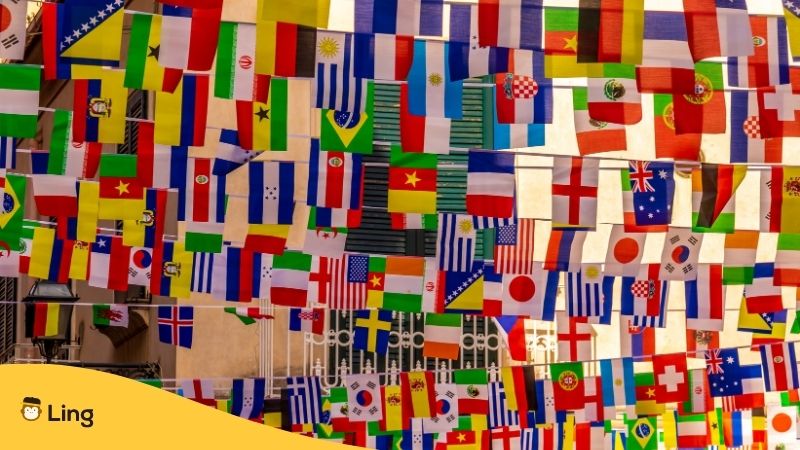It’s not just Vexillophiles (people with a passion for all things flag) who might find this blog on the Bosnian flag interesting. You see, flags, or zastava in the Bosnian language, are so much more than just colorful emblems that flap in the wind. A closer look at their design can reveal a lot about a country’s history, people, and culture. So, let’s dive in and see what the Bosnian flag tells us about the wonderful Bosnia and Herzegovina.
If you are a language learner looking to expand your linguistic horizons, consider exploring the Bosnian language through its flag. The Bosnian flag represents the country’s complex history and cultural diversity, and learning about the language through its symbols can provide valuable insights into the country’s people and traditions. So before we begin, take note of the following Bosnian words that can help you in this topic.
| English | Bosnian |
|---|---|
| Flag | Zastava |
| Banner | Barjak |
| Citizens | Građani |
| Patriotism | Patriotizam |
| Emblem | Amblem |
Bosnian Flag Design
The modern flag of Bosnia and Herzegovina features a yellow isosceles triangle on a blue background. Along the hypotenuse, a row of seven fully formed five-pointed white stars is displayed, with two white half-stars at each end of the row. The shape of the yellow triangle is meant to approximately represent the shape of modern-day Bosnia and Herzegovina on the map. Each point of the triangle is for the three constituent peoples: Serbs, Croats, and Bosniaks.
The white stars are representative of Europe and deliberately disappear off the edge line of the flag to represent an infinite number. The blue background is also meant to suggest a relationship with the color of the European Union flag. The three official colors traditionally represent both peace and neutrality.

History Of The Bosnian Flag
Flag Of The Bosnian Kingdom
The colors of the Bosnian flag have been associated with Bosnia for centuries. Between 1377 and 1463, the first flag was designed around the coat of arms of the Kotromanic dynasty. The white flag has the blue shield of the coat of arms emblem positioned in the center. This features a white bend or strap running diagonally across the center, separating three fleurs-de-lys in gold on either side.
Flag Of Western Herzegovina
Similar to the Ottoman flag, this flag was created in 1760. A left-pointing white crescent and star appear on a green flag with a swallow-shape background. The flag usually appeared when the troops of the Eyalet of Bosnia were mustered for war.
Flag Of The Bosnian Revolt
Making its appearance during the revolt of Husein Gradaščević against the Ottoman Empire during the 1830s, the flag of the Bosnian Revolt featured a yellow star and crescent on a dark green background.
Flag Under The Austro-Hungarians
When the Austro-Hungarian Empire annexed Bosnia and Herzegovina, they were split into two separate provinces. Both were given a flag with horizontal stripes in red and yellow. Essentially the same flag, the only difference between the two is that each flag features colors that have been reversed.
Flag Of Democratic Federal Yugoslavia
Between 1942 and 1946, the official flag featured a red star in the center of a white horizontal band between a blue horizontal band at the top and a blue band at the bottom. The new flag was flown outside the Yugoslav capital, parliament, and other official buildings.
Flag Of The Socialist Federal Republic Of Yugoslavia
During the period between 1946 and 1992, when the Socialist Republic of Bosnia and Herzegovina was under the control of communist Yugoslavia, the flag was moved as a canton into the top left-hand corner of a plain red background meant to represent communism and socialism. The new flag was designed to echo the flags of China and the Soviet Union.
Flag Of The Independent Republic Of Bosnia And Herzegovina
Bosnia and Herzegovina declared independence from Yugoslavia on March 3rd, 1992. In a kind of full circle, the coat of arms of the Kotromanic dynasty was chosen as the new flag. The ensign with its six gold lilies featured a blue field on a clean white background and was adopted on May 20th, 1992. Although it is no longer the country’s official flag, it is often brought out by Bosniak civilians at political rallies and football matches.
Flag Following The Dayton Agreement
This brings us to the post-1998 flag, which remains the official flag of Bosnia and Herzegovina flying from flagpoles across the nation today. Because of a disagreement in the Parliament of Bosnia and Herzegovina concerning the flag’s design, the decision was made by the United Nations High Representative for Bosnia and Herzegovina, Carlos Westendorp. The modern flag is designed not to represent any aspects of the country’s history so as not to offend the separate ethnic groups. For this reason, it is not particularly popular with some sections who prefer to be represented by the 1992-98 Bosnian flag.
Flag Day In Bosnia And Herzegovina
Flag Day celebrates the flag and its importance to the Bosnian people. It occurs on February 5th, also known as St. Vitus’ Day. This day was chosen because it is believed that he saved his people from being killed by an earthquake when they were praying in front of their church’s altar on this date.
The activities during Flag Day vary depending on where you live in the rest of Bosnia and Herzegovina. However, there are many familiar aspects. People will gather at schools or other public places with flags and banners to sing songs about patriotism and unity. There may also be speeches given by local dignitaries who talk about why everyone in Bosnia-Herzegovina needs to come together as one nation under one flag.
Learn Bosnian With Ling

Every nation’s flag tells a different story. With the Ling app, you can access stories from around the world about other peoples and their cultures through the platforms’ vast library of blogs and in-depth lessons. With over 60 different languages, the Ling app is the perfect springboard to learning a new language like Bosnian which other language-learning apps ignore. Download the Ling app at Google Play or App Store now and start your journey today.


































































